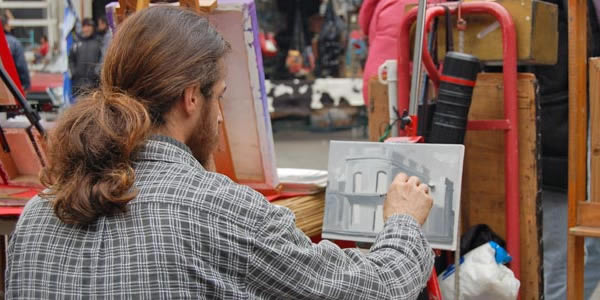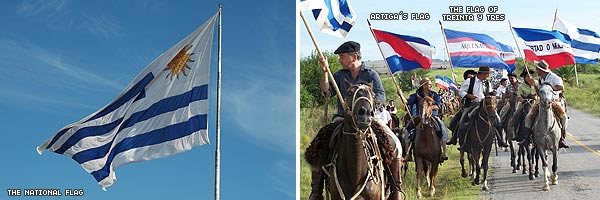USEFUL DATA of Uruguay
More about Uruguay

Name of the Country
The Eastern Republic of Uruguay owes its name to the location of its territory to the East of the Uruguay River. As a result of this geographical factor and certain historical events, the Uruguayan people have come to be called “orientales” (eastern people) even though Uruguay obviously belongs to the Western hemisphere. As far as the term "Uruguay" is concerned, it comes from the Guaraní tongue and it may be translated as “the river where the bird dwells ".
Geography
The total surface of Uruguay is 176,215 square kilometers featuring soft undulations. There are neither high mountains nor large plains. The scenery is dominated by a peneplain with rolling plateaus interrupted by water courses.
Mount Catedral is 514 meters high. It is the highest point in the country and it rules over a low range of hills which stands out in the landscape.
The large rivers which empty into the Atlantic Ocean make up a plentiful fluvial network in which four river basins stand out: the Río de la Plata, the Uruguay River, the Merín Lagoon, and the Negro River. These water bodies and their stream are important communication waterways, fresh water sources and power generators through the use of dams.
In addition to all this, its riverbank is 450 kilometers long and its seashore spans along 220 kilometers of precious beaches ideal for tourist development.
Climate
As it is located in the temperate zone of the Southern hemisphere, the climate at Uruguay is moderate with average temperatures ranging from 12ºC in the winter to 25ºC in the summer. Sunny days are predominant during almost the entire year. However, it is usual that the weather presents certain instability. The winds blowing from the North bring humidity and heat to the area, whereas the pampero gusts (the wind blowing from the pampas) and the Southern wind are colder and drier.
Population
According to the latest information provided by the National Statistics Institute, the total population number reaches 3,323,906 inhabitants, with a population density of 17.8 dwellers per square kilometer and an average age of 32.6. The highest concentration is given in Montevideo, with a 43% of Uruguayan citizens, which evidences its typically urban feature. The birth rate is the lowest in South America, but there is high life expectancy, with an average of 72 years old for men and 74 for women.
At the beginning of the organization of the state, the open migratory policy permitted the access of European immigrants, especially from Spain and Italy. In turn, there is a small portion of African descendants that arrived while the country was under Spanish domination. Unlike the rest of Latin American countries, Uruguay does not have any native population as all natives disappeared from the territory in the late XIX century.
Languaje
The official language is Spanish.
Religion
There is complete freedom of worship guaranteed by the Uruguayan Constitution and manifested all through the country in several different religions. Though the Roman Catholic is the most popular religion, professed by 56.2% of the Uruguayan, as it is the oldest faith in the republic, there are more than 70 different religions. The most outstanding are Protestantism, Judaism and Islamism.
Currency
Uruguayan currency is ruled by the Uruguayan Peso (urug $), equivalent to 100 cents. Metallic coins of 1, 2, 5 and 10 are issued, as well as banknotes of 50, 100, 500 and 1,000 Uruguayan pesos.
Constitution and Government
Uruguay is a democratic republic with a presidential system ruled by a national constitution whose latest reformation was carried out in 1996. Its system of government is based on three branches: executive, legislative and judicial. The executive branch is represented by the president and his ministers; the legislative branch is represented by the General Assembly, made up by the House of Representatives and the Senate; and the judicial branch is made up by the Supreme Court and courts located all over the country. Government representatives are voted by the Uruguayan people every 5 years.
The State is organized in 19 departments run by a municipal mayor also elected by vote. The City of Montevideo, capital of the country, lies on the Río de la Plata Bay.
Symbols
The national decree passed on February 18, 1952 established the national flag, the coat of arms, the national anthem, Artigas’ flag, the flag of Treinta y Tres and the national rosette as the symbols of the Republic.

The Uruguayan flag was adopted by law on July 12, 1830. Nevertheless, the flag created by national hero don José Gervasio Artigas and the flag used during the landing of 33 brave men on Agraciada Beach on April 19, 1825 are also official national symbols.
The national flower is the ceibo, a thorny bush grown in squares and parks but also growing in the wild on the banks of the Río de la Plata.
Holidays
The national holidays are as follows:
| January 1st: New Year |
May 1st: Labor Day |
July 18th: Oath of allegiance to the Constitution |
August 25th: Declaration of Independence |
December 25th: Christmas |
© 2007-2025 Total or partial reproduction forbidden. Derechos de Autor 675244 Ley 11723
Who we are | Contact us | Terms and Conditions



